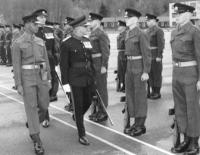In 1953 the Canadian Army introduced a plan to provide a military career opportunity for young men who were between 16 - 17 years old. This “Soldier Apprentice Program” was intended to address the Army’s personnel challenges in the post-war era and ensure that there would be a sound base of talented soldiers and leaders at the Senior Non-Commissioned Officer level. The two-year program provided trades training concurrent with upgrading the soldier’s academic qualifications. Under their Sapper Apprentice training, the Royal Canadian Engineers operated one of the most successful programs of the eight Army corps that participated.
Recruits had to have at least Grade VIII qualifications, be physically fit, and meet other selection criteria. They were enrolled for seven years but could request their release after five years. Franco apprentices trained in Quebec for their first year and joined the mainstream in their second year at the Royal Canadian School of Military Engineering in Chilliwack.
During their first two years of training half their day was occupied in academics and the remainder of the day was filled with military training. Graduates would hold Junior or Senior Matriculation in Math, Science, and English and could receive a diploma if they were successful on the British Columbia accreditation exam.
An Apprentice Training Squadron was established at RCSME to provide the academic training and was manned with carefully selected civilian teachers and military instructors. The staff was excellent in ensuring their charges met expectations - providing encouragement, instilling initiative, giving the discipline when necessary and, on more than one occasion, being ‘Mom and Dad’ for some adolescents who were a long way from their home.
Some 847 individuals entered this program over fourteen intakes. The first intake started training in 1953 and the final intake graduated in 1968. They completed a variety of trades courses and many served their initial posting in Construction Engineering Sections. Others set out on careers as Field Engineers and were assigned to the Army’s Field Squadrons.
With their talents and training, most were expected to achieve at least Sergeant rank. Many, however, achieved Master Warrant Officer or Chief Warrant Officer rank. Of the 564 graduates, many went on to distinguish themselves in military and civilian careers. Several earned their Queen’s Commission and became officers. One retired with the rank of Brigadier General. Twenty-five years after the last Apprentice graduated, the Sapper Apprentices were well-represented in the ranks of the senior non-commissioned members of the Canadian Military Engineers.
The Soldier Apprentice Program proved to be very successful in providing young leadership to the Army and provided a bright future for many Canadian men in both their military and/or civilian careers.
Watch a first hand account from our Video Library The Sapper Apprentice Programme - CWO Gerry Duguid (Ret'd)
